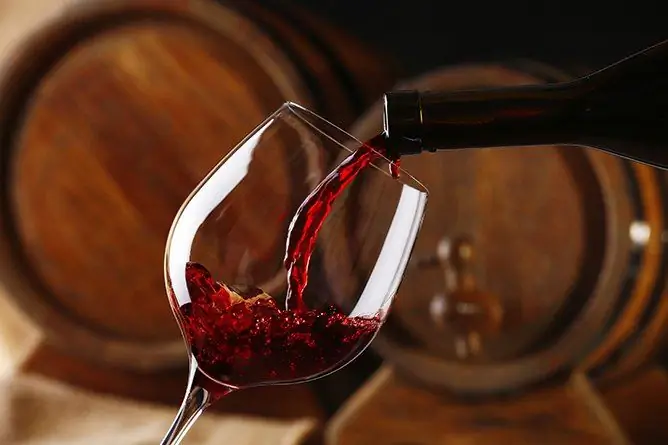- Author Rachel Wainwright [email protected].
- Public 2023-12-15 07:39.
- Last modified 2025-11-02 20:14.
Calorie content of wine
Wine as a product is a fermented grape juice. In the process of producing red wine, grape skins and seeds are always used, as they contain many valuable substances (tannins, which have an antiseptic effect on the gastrointestinal tract, and flavonoids), and also take an active part in the fermentation and infusion of the drink.
Calories in wine

The calorie content of wine (dry red) is about 70 kcal per 100 g of product. This type of wine is the most low-calorie: the calorie content of red semi-dry wine is relatively higher, and sweet dessert wines are high-calorie drinks.
The main value of dry red wine is that it contains a red pigment from grape peel - Reservatol, which has proven anti-cancer activity. The catechins of this wine protect the walls of the arteries from atherosclerosis. However, there is evidence that wine tannins can trigger migraine attacks.
Calories in wine are not the only selection criteria. In order not to harm one's own health and the health of loved ones, experts recommend using wine only from well-known manufacturers with a decent reputation in the market.
When buying wine, you should carefully consider the packaging: bottle, label and back label. All elements must be free of visible defects, and the inscriptions must be well readable. It is also necessary that the packaging indicates not only the calorie content of the wine and its manufacturer, but also the trade representation of the brand. An indirect sign of product quality is the bottle corking with a natural cork. If the cork is plastic, it makes sense to choose a different kind of wine.
A common misconception is the fact that age directly affects the calorie content of wine and its taste. In fact, not everyone is able to distinguish between wines of different ages, so when choosing it is better to focus on your own taste preferences and calorie values of wine.
In order to fully experience the aroma and taste of the drink, you should also follow the rules for pouring it into glasses. For white wine, more compact containers are chosen, while red wine requires more volume.
Sunlight contributes to the destruction of the drink. It is for this reason that wine is usually bottled in dark glass bottles (with the exception of wines from some white grape varieties), and it is recommended to store the drink in a cool and dark place. If there is such a possibility, then during storage it is preferable to give the wine a horizontal position - this will allow the cork to remain moist all the time and exclude air from entering the product.
Despite the low calorie content of dry wine and other valuable properties of the drink, the maximum daily dose of its consumption for a healthy person should not exceed 100 g. In no case should wine be consumed even in small doses during pregnancy, as this can cause significant harm to health fetus. Wine should be used with caution by people with a tendency to rosacea, since the drink expands the surface vessels, including the skin of the face.
In order for the drink to be consumed at the recommended temperature, hold the glass by the stem; also, you should not fill it to the very brim in order to be able to smell the wine. Sweet and active products can significantly increase the calorie content of dry wine and ruin the wine bouquet, therefore it is recommended to use it with cheeses, olives or fruits.
A number of nutritionists are inclined to consider dry white wine a valuable dietary product. The calorie content of dry white wine is about 66 kcal per 100 g of drink, while it is rich in valuable nutrients. Dry red wine has a beneficial effect on the digestion of proteins and fats, therefore it is traditionally served with heavy meat dishes, and is also used as a marinade for kebabs and similar dishes.
Calories in Wine and Wine Diet
It is no secret that there are two opposite points of view about the effect of wine on body weight. According to one of them, the calorie content of red wine as a representative of the alcoholic category of products inevitably contributes to a set of extra pounds. At the same time, according to another point of view, the wine diet, on the contrary, is able to contribute to the normalization of weight.
One of the primary roles in influencing the figure belongs not only to the calorie content of red wine, but also to the quality of the drink. Reconstituted, diluted wines containing extraneous additives are really dangerous to health, while quality wine normalizes blood cholesterol and promotes the proper absorption of fats from food.
Trying to find such a wine on the counter of a store, one should not be guided solely by the price of the product - the most expensive collection wines are not intended for daily use, their taste is understandable only to gourmets, and the price consists of the actual cost and the huge market markup.
Inexpensive wines from southern countries - Chile, Australia, Argentina - have a low price with decent quality. In addition, products of this kind are much less likely to be counterfeited. Of the more familiar producers, traditionally high-quality drinks are offered by Crimean, Moldovan and Georgian winemakers.
As part of the wine diet, exclusively dry wine is shown. If the arrow of the scales deviates to the right, then the body weight gain is due to the amount of food eaten: no one has canceled the property of wine to stimulate appetite. Of course, such a wine diet excludes the use of high-calorie sweet wines.

In addition to the caloric content of white or red wine, another postulate of the wine diet is the permissible dose. It is well established that the third glass will be deposited at the waist and on the hips, thus, it is allowed to consume no more than two glasses a day. In order to facilitate compliance with the recommended dose, it is better to drink wine diluted with cold mineral water.
Of course, in this case we are talking about dry ordinary wines. This way of drinking wine dates back to ancient Greece and is a great help for those who have a tendency to be overweight. Today it is quite relevant, and many European restaurants offer their guests "diluted wine" (for one part of wine, two parts of water).
Before deciding to follow a wine diet, you should consult your doctor, since not only a number of diseases, but also taking certain medications can become a critical contraindication for regular alcohol consumption.
An excellent alternative can also be a low-calorie white or red non-alcoholic wine, which also has phenolic compounds that lower cholesterol levels, as well as fruit acids that stimulate digestion.
Found a mistake in the text? Select it and press Ctrl + Enter.






